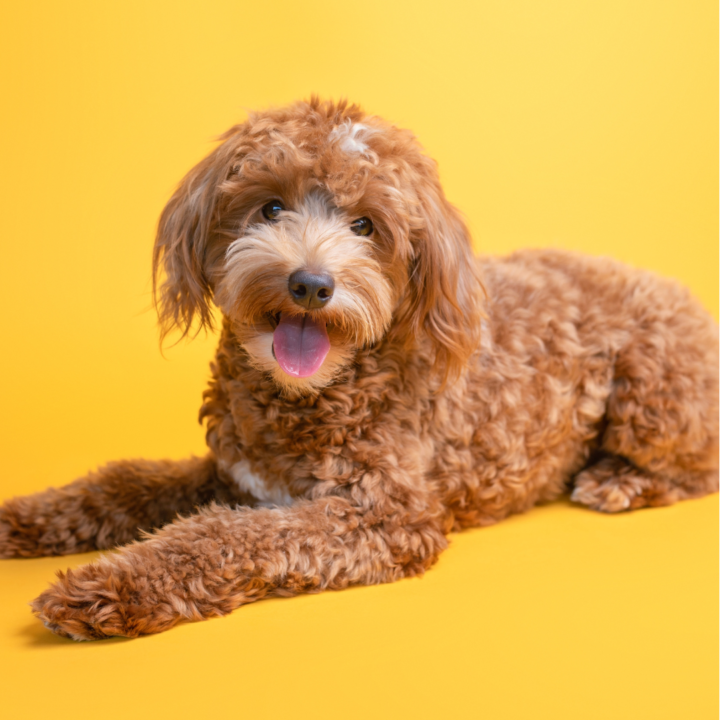Bernedoodles can be left alone at home, but only for specific periods. However, it is crucial to consider your dog’s needs and ensure they are comfortable alone.
Want to get a Bernedoodle as your pet but worried about leaving it alone during work hours? People around the globe have grown to love Bernedoodles due to their playful and affectionate nature.
Their distinctive appearance and soft, wavy coat make them among the most adorable dog breeds, along with teacup dogs.
Can Bernedoodles be left alone? Bernedoodles, even full grown Bernedoodles, may develop separation anxiety when left alone for a long time.
Unattended stress may cause your furry friend’s physical and mental health to deteriorate.
Therefore, working out ways to deal with this breed’s anxiety is essential.
The Nature of Bernedoodles
The Social Behaviour Of Bernedoodles
People usually ask what is an f1b bernedoodle and what is their nature like?
Bernedoodles are a cross between a Bernese dog and a Poodle.
Bernedoodles are known for their friendly and social nature. They are affectionate and people-oriented dogs that thrive on human interaction.
They are usually welcoming to family members and strangers, making them good companions in social settings. Children and other house pets often love their playful and outgoing demeanor.
Alongside intelligence, Bernese Mountain Dog Doodle breed wants to please their owners. This quality makes it easier to shape them as well-behaved family pets.
Strong Pack Mentality In Doodles
A firm pack mentality in Bernedoodles means they love being part of a group. They tend to form deep bonds with their human and doggy pack members, showing loyalty and dedication.
Doodles might establish a pecking order in a household with multiple dogs, influencing how they interact and behave. They’re cooperative and like working with others, whether playing or training.
With the right approach, Doodles’ pack-oriented nature could be embraced for a harmonious relationship.
The Impact Of Loneliness And Separation Anxiety
Loneliness comes from insufficient social interaction, making dogs feel sad and anxious. Based on can Bernedoodles be left alone, can also lead to behavior changes and health problems.
Dogs are social creatures so loneliness can affect their emotions and relationship with their owners.
Separation anxiety is even more severe, causing full grown Bernedoodle dogs extreme fear and stress when left alone. This often results in destructive behavior and health issues, creating tension for everyone in the household, including neighbors.
In really bad cases, it can lead to owners putting up their Bernese Mountain Dog Poodle Mix for sale.
To prevent these problems, training and socializing your dog correctly is essential.
Does Apartment Life Trigger Separation Anxiety?
Living in an apartment doesn’t directly trigger separation anxiety in either young or full grown Bernedoodle dogs. However, they prefer to live with their owners rather than being left alone for a long time.
In a smaller living space, dogs may have fewer opportunities to find distractions or entertain themselves alone. This lack of mental stimulation can make them feel more lonely and anxious.
Increased indoor time can lead to feelings of isolation, as they may not have access to outdoor sights, sounds, and smells.
Addressing The Prone Separation Anxiety
Role Of Owners In Shaping Behavior
Owners have to put in efforts to ensure that their Bernese Mountain Dog Doodle does not feel separation anxiety.
You can help your Bernedoodles feel more at ease when left alone by socializing them early and getting them chews to keep them busy.
Owners may set up a playpen for their Bernedoodle, based on mini Bernedoodle how big do they get. They can enjoy playing in it when alone at home.
Creating a consistent daily routine and providing safe spaces like crates can ease anxiety. Interactive toys can keep them mentally engaged.
It’s essential to understand and not punish anxious behaviors.
Importance Of Early Training And Socialization
When puppies are little, they learn loads of stuff that sticks with them even when they turn into a full grown Bernedoodle.
Therefore, early training and socialization serve as the building blocks for a well-trained dog.
Socialization is about exposing them to different people, animals, places, and situations. It makes Bernedoodles more confident and less likely to be scared or aggressive later in life.
Early training, on the other hand, helps them understand and follow commands, making their bond with their owners stronger.
In addition, these practices prevent problems and keep dogs engaged and adaptable to different situations.
Crate Training: Creating A Safe Haven
- Establishing a Consistent Routine: Create a regular schedule for your Bernedoodle’s crate time, including bathroom breaks. Look out for Amazon puppy pads to avoid the spread of infections. This would allow your dog to become accustomed to the crate environment.
- Making the Crate Cozy: Add a soft bed, blankets and toys for dogs to make the crate comfortable and inviting. Ensure that you choose a comfy crate from the different crates for small dogs available.
- Gradual Alone Time: Slowly increase your Bernedoodle’s time in the crate. Start with short periods and gradually extend the time as they become more accustomed to it.
- Using Positive Reinforcement: Reward your Bernedoodle with treats and praise when they enter the crate willingly or remain calm inside.
- Avoiding Punishment: Never use crates as a form of punishment. It should always be a safe and positive space for your Bernedoodle.
- Ensuring Adequate Exercise: Prioritize regular exercise and playtime outside the crate to help your Bernedoodle release energy and reduce restlessness when confined.
- Cleanliness: Based on do Bernedoodles shed, ensure to clean the crate daily. This would help protect your little friend from catching diseases or getting irritated.
Strategies For Alleviating Separation Anxiety
Separation anxiety may exist in all kinds of Bernedoodles, be it Bernedoodle brown or Bernedoodle golden mountain doodle. Addressing this issue in your dog requires a multi-faceted approach.
Reward Calm Behavior: Reinforcement Techniques
- Positive Departure Association: Create a positive association with your departures by offering special treats or toys only available when you’re not home.
- Quiet Return Greetings: When you return home, wait for your dog to be calm before greeting them, rewarding them for their composed demeanor.
- Progressive Alone Time: Gradually increase the duration of your departures and reward your dog for remaining calm during these lengthier intervals.
- Desensitization to Cues: Counter-condition your dog by exposing them to departure cues, like picking up with keys, without leaving. Reward them for remaining calm with treats.
- Randomized Departures: Occasionally vary the times and routines of your departures so your dog doesn’t anticipate your departure cues, rewarding them for adaptability.
Use Calming Treats And Aids
Calming treats contain natural ingredients that can help dogs relax during stressful situations. They help create a positive association with alone time.
Calming aids like Thunder Jackets provide comfort by applying gentle pressure, similar to swaddling a baby.
When used alongside training and gradual desensitization, these aids and treats can significantly reduce separation anxiety, making a dog’s time alone more comfortable.
Incorporating Exercise And Routine
Doodles are known for their high energy, and it’s vital to understand and meet their exercise needs.
Daily exercise helps them stay physically and mentally balanced, reducing restlessness and promoting a calm demeanor.
This is especially important when dealing with separation anxiety, as a well-exercised Bernedoodle is more likely to feel relaxed during alone time.
Based on can Bernedoodles be left alone, morning walks and yard play are essential for preparing Doodles for alone time.
A morning walk not only fulfills their exercise needs but also stimulates their senses, setting a positive tone for the day. Yard play lets them burn off energy in a familiar environment, reducing anxiety-related behaviors.
Crafting A Comprehensive Routine
Creating a detailed schedule for your Bernedoodle dog allows it to overcome separation anxiety. Owners showing up at a particular time would enable them to expect without disappointment.
- Morning Exercise: Start the day with a brisk morning walk or play session. This helps your Bernedoodle burn off excess energy and prepares them for a more relaxed day.
- Feeding Schedule: Establish a consistent feeding schedule. This provides your Bernedoodle with nourishment and creates predictability in their routine.
- Mental Stimulation: Incorporate mental stimulation activities like puzzle toys or obedience training sessions.
- Practice Departures: Based on can Bernedoodles be left alone, practicing brief departures several times a day could help. This helps your dog get used to the idea of you leaving without causing anxiety.
- Interactive Toys: Provide interactive or treat-dispensing toys to engage your dog during alone time mentally.
- Midday Check-Ins: Arrange for a midday check-in or walk. This can break up the day and provide social interaction for your Bernedoodle.
- Evening Exercise: End the day with another exercise session. A tired Bernedoodle dog is less likely to be anxious, so an evening walk or playtime is essential.
- Bedtime Routine: Establish a calming bedtime routine to help your Bernedoodle wind-down and prepare for a restful night’s sleep.
Consistency is essential for a routine to have its impact. Dogs thrive on predictability, and a dependable schedule helps reduce anxiety.
Identifying And Addressing Anxiety Triggers
- Observation: Pay close attention to your dog’s behavior and body language to identify triggers.
- Common Triggers: Based on can Bernedoodles be left alone, Recognizing common anxiety triggers is essential. These could be loud noises, specific situations, or changes in routine.
- Desensitization: Gradually expose your dog to triggers in a controlled and positive manner to reduce their sensitivity.
- Counterconditioning: Pair triggers with positive experiences or rewards to change your dog’s emotional response.
- Behavior Modification: Work with a professional dog trainer or behaviorist to develop a customized plan for addressing specific triggers.
- Management: Implement management strategies to avoid or minimize exposure to known triggers.
- Medication: In severe cases, consult a veterinarian about medications to help manage anxiety.
Long-Term Maintenance
- Reinforcing Positive Behavior: Continue supporting positive behavior throughout the Bernedoodle lifespan, not just during puppyhood. This encourages your Bernedoodle to repeat desirable actions and behaviors.
- Consistency: Maintain a consistent approach to training and behavior reinforcement. This consistency helps your Bernedoodle understand expectations and builds trust between you and your dog.
- Adapting To Your Bernedoodle’s Growing Age: As your Bernedoodle grows and matures, its needs and preferences may change. Monitor their dietary and exercise needs, especially if they become less active or face age-related health concerns.
- Professional Help: Based on can Bernedoodles be left alone, professional help may be needed to address certain behavioral issues.There is no shame in asking for help when needed.
Final Verdict
Can Bernedoodles be left alone? Bernedoodles can indeed be left alone, but it requires proper training and thoughtful considerations.
Establishing a consistent routine and using positive reinforcement techniques can ease separation anxiety and foster independence.
Balancing their professional lives with the care of your full grown Bernedoodle is achievable. Empowerment lies in knowledge and resources, enabling working women to provide the best care for their Bernedoodle companion.


This was very helpful. Thank you!